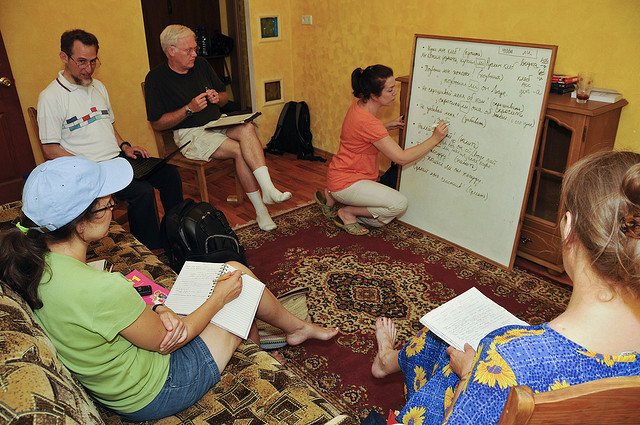How Bryn Mawr’s Sharon Bain learned about culture shock
By Tianyuan Zhang
Sharon Bain never expected she would be shocked by her own native culture.
On December 23rd, 1991, Bain returned to America from Russia, where the Communist regime was about to collapse. She went grocery shopping for the first time in four months. As she wandered down the aisle of laundry detergents, surrounded by different brands of detergents for different machines with different scents, Bain was surprised and completely lost. She stood there, indecisively, until her mother came, grabbed a box of detergent and took her home.
“In Russia, you were happy if you could find a bag of sugar,” said Bain, “But in America, not only were the stores filled with things you really needed, but also with things that nobody needed.”
Bain started wondering why culture shock happened and how the differences between two cultures reconciled. Seventeen years later, as a lecturer in Russian department at Bryn Mawr College, she has designed a writing seminar called “Culture Shock,” which focuses on the understanding of stories about people entering new cultures.
“Culture shock is a constant process of assessment and diagnosis,” she said. “I like sharing my experiences of navigating new cultures and the way which helps me become the person I am.”
Bain’s exposure to culture shock started as early as when she was six months old, when her family moved from Virginia to south California.
“I grew up in that casual culture,” she said, “I called my friends’ parents by their first names.”
At age 12, she moved to South Carolina, the conservative “Bible Belt.” There she had her first taste of culture shock. While enjoying the southern hospitality, Bain learned the importance of respect, addressing people as

Sharon Bain at the whiteboard
“Mister” or “Missus” and saying “yes, Sir” instead of simply “yes.”
Four years later, Bain moved to Pennsylvania, where she described as a “more reserved” place. Different from the cordial South, said Bain, friendships in the Northeast took more time to form.
Bain said her early experience of seeing things she liked and disliked around the country indirectly influenced her future interest in Russian and other cultures.
It was during the Cold War when Bain decided to learn Russian.
She just came to the Philadelphia area.
“I was the new kid. I was already odd, so why not?” Bain joked about her decision, “but Russian also interests me.”
Her interest came from her doubt in what she saw in the media. Russians were always the evil guys on the screens, Bain said. She figured there must be more than that.
“It’s not possible that all Russians are bad,” said Bain, “I wanted to find out the truth.”
She finished a B.A. in Russian studies at University of Delaware, got her M.A. at Bryn Mawr College in 1998, taught Russian at University of Delaware from 2002 to 2004, and has worked at Bryn Mawr College since 2004, after she finished her Ph.D. Continue reading →




